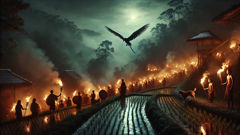Introduction
Night in the islands of the Philippines carries more than the hush of palm leaves and the distant toll of a water buffalo bell; it carries a memory that children use to measure the universe. They tell of a winged hunger that lives between the tide and the rice terraces, in the black cavities beneath the Mangyan cliffs and the nipa roofs of fisherfolk villages. The Wakwak is not merely a rumor. It is a shape imagined from the stifled screams of a centuries-old world where dusk meant danger, and moonless nights meant calculation. Elders describe it with the impatience of those who have lived under the shadow of things that do not forgive mistakes: as a bird that walks on wind, a vampiric shape with long talons and a throat that seeks warmth. It arrives with a sound—wakwak, wakwak—like a joke told wrong, like a hinge catching in the dark. Yet the name is deceitfully casual for something that can strip a home of comfort. Some versions make the Wakwak a once-human curse, others an elder spirit or monstrous bird spawned from the sea's envy. Across islands, the details change but the caution remains: lock doors, hang garlic or salt, keep family close. This story gathers those scattered voices into a single lantern-lit path. It traces the creature's origins through ritual and rumor, reconstructs nights when villagers starved their own fear to keep infants breathing, and follows a small band of people—an herbalist, a fisherman, a seamstress—who learned how to face a terror that does not always die with daylight. In doing so, it explores not only the anatomy of a myth but the brittle human economies of courage, superstition, and survival that let whole communities keep living with the wakwak's shadow above their roofs.
Origins and Variations: How the Wakwak Took Shape
The Wakwak's story begins where human imagination meets night, and like all such beginnings it refuses a single origin. In one telling, the Wakwak is an ancestral punishment—someone who committed an unforgivable act and was stripped of human comfort and given a night appetite. In another, it is a common bird touched by a sorrowful spirit, transformed by grief into a creature that feeds on the living. Coastal communities insist the wakwak is a remnant of the sea's old bargains: a bird that once traded feathers for fish and left with salt in its beak and malice in its heart. Mountain villages speak of it as an omen: a winged ghost that heralds misfortune. The variety of origin stories is itself a map. Each island and dialect adds details that stitch the wakwak to local fears. In the Visayas, older parents tell children the wakwak's approach is marked by a hush in the rice fields and a sudden chorus of frogs that fall silent. In Mindanao, some elders paint it as a nocturnal hunter who favors young and infirm, while in Luzon it whispers through stories of a creature that steals only the lightest parts of the night—laughter, breath, sleep. Regional variations also change the monster's shape. Sometimes the wakwak is described as a large, hawk-like bird with a hooked beak and feathers black as old soot. Talons curve like sickles, and wings tear the sky into ragged bands. Other accounts complicate this simple bird-form: the head may be human, the limbs grotesquely long, the face a mask of the one it once was. Folklorists note a pattern that crops up across these accounts: the wakwak often has two voices, one that mimics the living—a child's cry or a lover's whistle—and another that is an empty echo, the wakwak's own. The mimicry is functional and cruel; it lures. Close-reading local oral histories reveals another layer: the wakwak is also a social creature of rumor. When unexplained misfortune strikes—a poor harvest, a sudden illness, the death of a child—communities sometimes speak of the wakwak to make a shape of grief. Saying the name organizes chaos. It places blame on a creature that lives in the dark so people can carry on in the daylight.

Between paragraphs one and two an image appears: the glow of a lantern illuminating a child's small feet, and above, a feathered silhouette like a missing stanza.
A consistent thread in wakwak lore is its appetite and its method. Unlike the dramatic vampire of European imagination, the wakwak is rarely said to bathe its victims in blood. Instead, older tales are instructive about dismemberment and removal: hands left upon the threshing floor, a torso found at dawn without its head, limbs inexplicably missing from a hammock. The wakwak's violence is domestic and measured; it reaches into houses as cleanly as a thief lifting a coin. This clinical detail served a function in pre-modern life: it explained sudden absence, scandalous births, or the unspeakable outcomes of unexplained nighttime raids. Anthropologists who visited the islands in the early twentieth century observed that communities with tight-woven kinship networks tended to adapt the wakwak narrative as a cautionary tale about leaving children unattended, locking granaries, and policing transgressions within households. The wakwak story reinforces collective responsibility. In some places the legend is a moral mirror. The creature punishes those who flout taboo—women who leave during certain periods, neighbors who hoard rice, men who ignore funerary rites. Elsewhere, the wakwak functions less as a moral enforcer and more as an emblem of danger that cannot be disciplined: it is the randomness of the world given feathers and a call.
The wakwak's symbolic elasticity explains why it endures. It is at once predator and parable, ghost and instrument. It has slipped into modern mediums—television segments, online forums, even tourist tales—because each era retells it to hold a new fear. In wartime accounts, the wakwak was woven into the larger tapestry of threats: enemies by night, betrayal by neighbor, hidden bombs in the dark. Under the blue light of the digital age, the wakwak takes new forms in comment threads and local news digests, sometimes stripped of ritual but not of terror. Yet the shape that captures attention is not only fear. The wakwak endures because it organizes the night. It gives families strategies: salt on thresholds, specific prayers, leaving a small bowl of bloodless offerings at a window, the ritual of a rooster kept awake for the call. These practices map survival. They are a small war against the dark.
Beyond cultural utility, the wakwak's anatomy tells us something about human perception. It is not simply a bird; it is the bird the mind sketches when it wants to make sense of absence. The feather that falls without a sound, the small spoor in damp earth, a child's scream muted by distance—these are things that compel explanation. The wakwak answers with grandeur. Yet its existence is as much metaphor as monster: a testament to how people live under conditions that can be sudden and unexplainable. In language and ritual, the wakwak is a community's negotiation with contingency. From origin story to regional variant, it is a reflection of survival strategies, social norms, and the terrible need to name what is otherwise impossible to face.
Encounters and Survival: Families, Remedies, and Night Tactics
If origins give the wakwak shape, encounters give it life. The most persistent narratives are the eyewitness and near-miss accounts that communities pass down. They are visceral and oddly domestic: a woman wakes to the sensation of fingers having been taken from her palm, the morning light revealing an empty bed beside her; a fisherman returns to find a child in a hammock alive but missing a small portion of the thigh; a family dog barked all night and in the morning lay flattened under a veranda, its coat eaten in patches. Such stories circulate in a cadence that shapes communal behavior. They are not always tall tales. Many are functions of interpretation—when trauma is raw, meaning must be made—and yet they also contain kernels of repeated detail that hint at common experiences. Villagers speak of the wakwak's preference: infants, the recently dead, and those who sleep alone. Why those targets? Practical explanations intertwine with the supernatural. Babies are vulnerable and noisy; the recently dead are ritually unstable, and lone sleepers are less likely to be watched by the communal eye. To protect themselves, people developed strategies that are as inventive as they are ritualized.

First, there are architectural measures. Nipa huts, though fragile to the storm, afford certain defenses: high platforms, woven mats, and suspended hammocks become layers of safety. Families learned to keep infants close to the parents' chest rather than left at the edge of the home. In some coastal villages, fishermen carve small notches into their boat hulls or hang strips of woven palm that act as talismans, believed to confuse a wakwak's path. Salt and garlic—common and cheap—dominate the repertoire. Salt is seen as preserving boundaries; piles near the door are invited to mark limits the wakwak won't cross. Garlic, often associated with other vampiric myths globally, appears in local practice too, strung across windows or tucked under pillows. These items are less about the biochemical power of their scents and more about symbolic deterrence. They give people a ritual to perform when fear might paralyze them. Ritual itself is protective; the action of doing something matters.
Second, nightly routines hardened into social law. Villages enforced curfews: no one walked alone after dusk, and those who had to travel kept flames or torches and walked in groups. If a child cried outside the home at night, the parent was expected to retrieve the child immediately and recite a protective invocation. In a handful of documented cases, women claimed that chanting certain ancestral phrases at the edge of the yard would make the wakwak hesitate long enough for the family to gather. Conversely, misfortune could be remedied by confession: families who experienced wakwak visits often conducted small restitution ceremonies, inviting a midwife or elder to offer rice and betel nut to the household spirits. These reparative acts read like social stitches: admitting vulnerability, gathering witnesses, and reaffirming communal bonds.
Herbalists and folk healers played a pivotal role. They knew which leaves, roots, and smoke could calm an infant and believed which preparations confused nocturnal predators. Steam baths of pandan leaves, decoctions of guava and tamarind, and fumigations with bayleaf smoke appear across many remedies. One herbalist's method, recorded in an island chronicle, involved mixing ground turmeric with salt, painting a thin line around a child's bedding while singing a lullaby that makes little sense outside its performance: the melody itself was the charm. Healers treated wakwak survivors with a combination of physical care and ritual: bandaging wounds, applying poultices of crushed nangka bark, and tying protective strings embroidered with everyday blessings. These treatments reinforced the idea that the wakwak attack is both bodily and spiritual.
Then there are the moral lessons layered over practical measures. Stories of families ignoring warnings—leaving a door unlocked during typhoon season, rejecting an elder's counsel—end with the wakwak visiting. These narrative forms teach respect for tradition and attentiveness to the social web. But not all tales moralize. Some are elegiac: the wakwak as a natural predator in a world where humans are not always the victors. In those narratives, the wakwak evokes ancient food chains and a world less tamed by human order. Modern science sometimes slips into the shadow of these tales as explanation. Owls, fruit bats, and large raptors can be misidentified in the dark; rabid animals behave erratically; human perpetrators may disguise night crimes as wakwak attacks to avoid blame. Even with those possibilities, the wakwak persists because it performs a function communities need: a story for loss, a vocabulary for danger, a ritual for reclaiming safety.
Encounters with the wakwak also produce resistance. The story of three villagers who organized a night watch and chased a wakwak from their fields is remembered not because it proves the creature's mortality, but because it showcases the social power of collective action. Threats that are elusive strengthen communal cohesion. In the morning after a wakwak call, feasts might be held to celebrate survival; neighbors share rice and tears. Such gatherings are the human answer to loss. They ritualize survival and make a place to mourn. They also produce a cultural archive—a ledger of strategies that get passed down and adapted. In contemporary times, radio broadcasts and community bulletin boards repeat these avoidance techniques. The wakeful translation of old rituals into new media is evidence of a living tradition, not a fossil. The wakwak remains potent because people keep telling the story and keep testing the tactics, mixing herb and prayer, torchlight and common sense, to make the night a little less hungry.
Conclusion
The Wakwak is more than a creature of fright; it is a cultural lens that examines how communities make sense of the dangerous and the unexplained. Across islands and dialects, it has been a means of explaining loss, enforcing caution, and weaving social norms into daily practice. It teaches the living how to protect infants, guard grain, and keep watch through nights that would otherwise leave them helpless. At the same time, the wakwak resists neat explanation: it is metaphor and monster, moralizer and mystery. In the modern world it continues to appear in news segments, fiction, and social media, sometimes purged of ritual but never of its capacity to unsettle. The human responses—architectural measures, herbal remedies, night watches, and communal rituals—reveal a pragmatic creativity: people invent protections that both soothe fear and have practical effects. Where science offers possible misidentifications or human malice as explanations, cultural practice offers meaning and solace. The wakwak persists because people need something to name the darkness with, and because telling its stories keeps communities bound. Those who listen to the elders, string salt at the door, or leave a small offering by the window do not only ward off a mythical bird; they participate in a living heritage, a set of actions and ideas that have allowed communities to survive under the hush of the night. The wakwak legend is not only an echo from the past but a compass for nights yet to come: a reminder that even in fear, people craft practices to protect what they cherish, and that stories can be both shelter and warning for those who sleep close together under fragile roofs.













